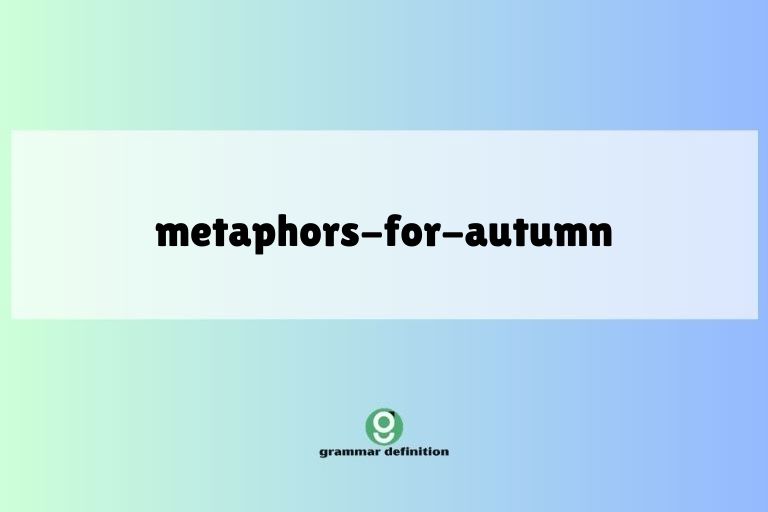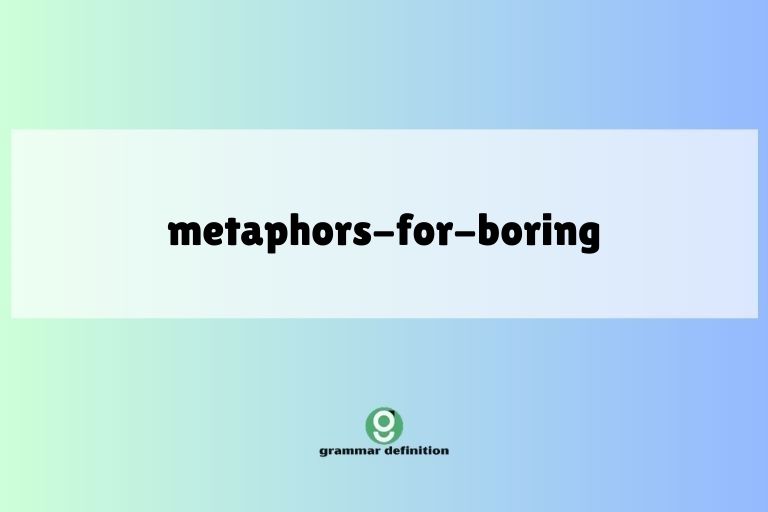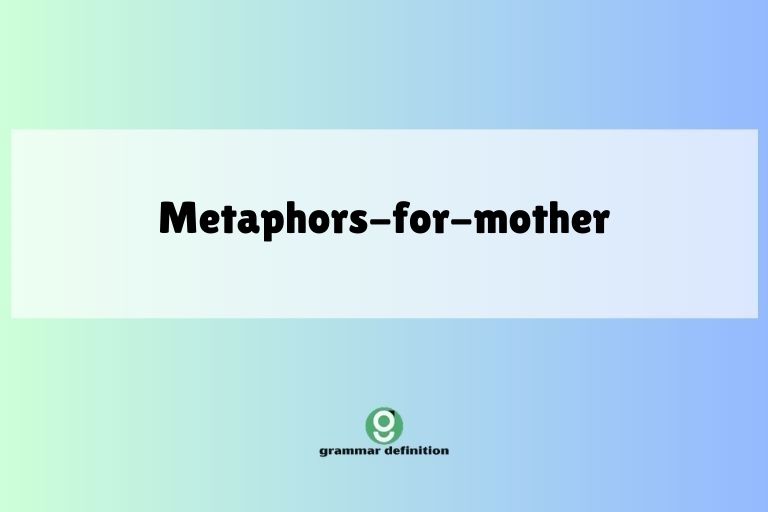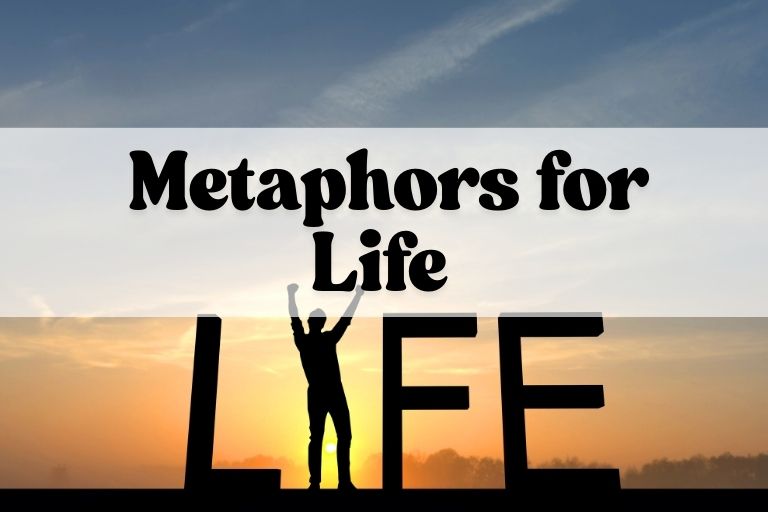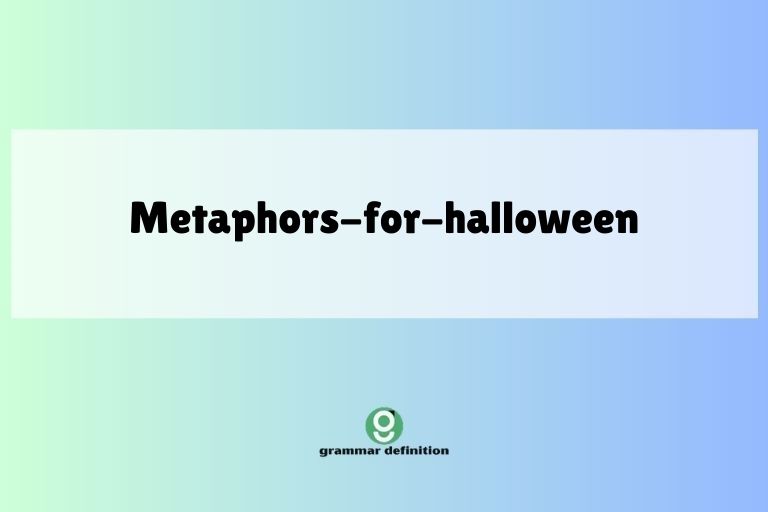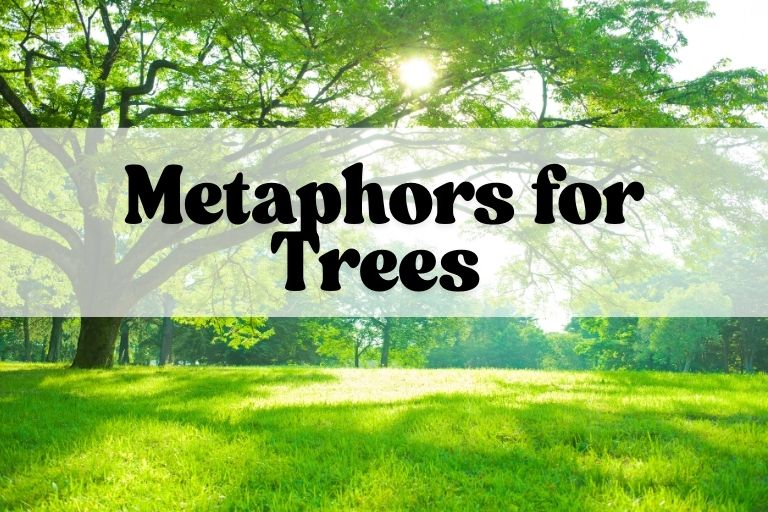Metaphors for Night: A Comprehensive Guide
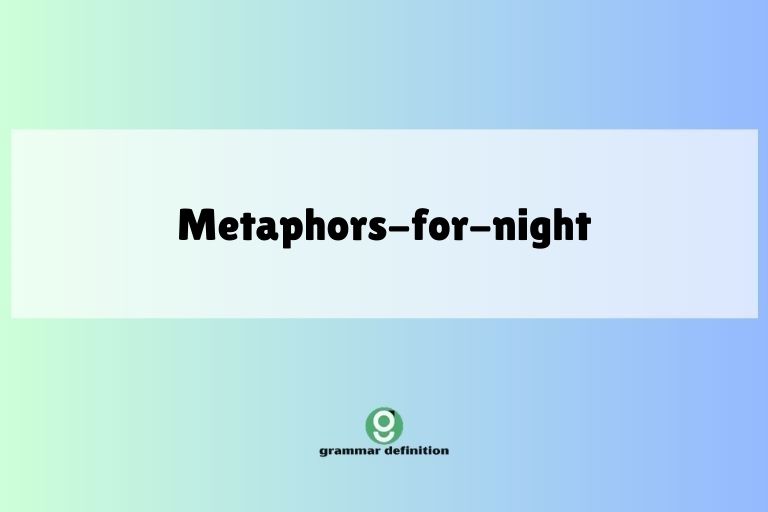
Understanding metaphors is crucial for mastering English, as they enrich our language and enhance our ability to express complex ideas vividly. Metaphors for night, in particular, are frequently used in literature, poetry, and everyday conversation to evoke atmosphere, emotion, and symbolism.
This article provides a comprehensive guide to metaphors for night, exploring their definition, structure, types, usage rules, and common mistakes. This guide is perfect for students, writers, and anyone interested in improving their understanding and use of figurative language.
Table of Contents
- Introduction
- Definition of Metaphor for Night
- Structural Breakdown
- Types and Categories
- Examples of Metaphors for Night
- Usage Rules
- Common Mistakes
- Practice Exercises
- Advanced Topics
- FAQ
- Conclusion
Introduction
Metaphors are powerful tools in the English language, allowing us to convey ideas and emotions in a more imaginative and impactful way. When we talk about “night,” we often go beyond literal descriptions, employing metaphors to capture its essence, mood, and symbolic significance.
Understanding these metaphors not only enhances our appreciation of literature and poetry but also improves our own writing and communication skills. By exploring various metaphors for night, we can gain a deeper understanding of how language shapes our perceptions and enriches our understanding of the world around us.
The effective use of metaphors can transform mundane descriptions into vivid and memorable imagery. Night, with its inherent darkness, mystery, and tranquility, provides fertile ground for metaphorical expression. This article aims to equip you with the knowledge and skills to recognize, interpret, and create compelling metaphors for night. Whether you are a student studying literature, a writer seeking to enhance your prose, or simply someone who appreciates the beauty of language, this guide will offer valuable insights and practical exercises to deepen your understanding.
Definition of Metaphor for Night
A metaphor is a figure of speech that directly compares two unrelated things, asserting that one thing is another, not just that it is like another (which would be a simile). A metaphor for night, therefore, uses night as a point of comparison to describe something else or uses something else to describe night, highlighting shared characteristics or creating a symbolic association. The goal is to create a more vivid and evocative image than a literal description would provide.
In this context, metaphors for night often explore themes of darkness, mystery, peace, danger, or the unknown. The specific characteristics highlighted depend on the context and the intended effect.
For example, night might be described as a “velvet curtain” to emphasize its softness and darkness, or as a “silent predator” to evoke a sense of danger and suspense. Understanding the intended comparison is key to interpreting the meaning and impact of the metaphor.
Classification and Function
Metaphors can be classified in various ways, but for our purposes, it’s helpful to consider them in terms of their function. Metaphors for night often serve to:
- Create imagery: They paint a picture in the reader’s mind, making the description more vivid and memorable.
- Evoke emotion: They can create a sense of peace, fear, wonder, or any other emotion associated with night.
- Symbolize ideas: Night can symbolize death, the unknown, rest, or a time for reflection.
- Add depth and complexity: They can add layers of meaning to a text, inviting the reader to interpret the metaphor on multiple levels.
Context
The meaning of a metaphor for night is heavily dependent on context. The same metaphor can have different connotations depending on the surrounding words, the tone of the piece, and the overall theme. For example, “night as a blanket” might suggest comfort and security in one context, but oppression and suffocation in another. Therefore, it’s crucial to consider the context when interpreting metaphors for night.
Structural Breakdown
Metaphors, including those for night, typically consist of two main elements: the tenor and the vehicle. The tenor is the subject being described (in this case, night), and the vehicle is the object or concept used to describe the tenor. The vehicle carries the metaphorical meaning and transfers its attributes to the tenor.
For example, in the metaphor “Night is a black cat,” the tenor is “night,” and the vehicle is “black cat.” The metaphor suggests that night is stealthy, mysterious, and perhaps a little ominous, drawing on the common associations with black cats. The effectiveness of the metaphor depends on the shared characteristics between the tenor and the vehicle.
Implicit vs. Explicit Metaphors
Metaphors can be either explicit or implicit. An explicit metaphor directly states the comparison, often using the verb “to be” or a similar linking verb. For instance, “Night is a canvas of stars” is an explicit metaphor.
An implicit metaphor, on the other hand, implies the comparison without directly stating it. For example, “The city slumbered under a blanket of darkness” is an implicit metaphor, suggesting that night is like a blanket without explicitly stating the comparison.
Implicit metaphors can be more subtle and require the reader to infer the connection between the tenor and the vehicle.
Types and Categories
Metaphors for night can be categorized based on the specific qualities or characteristics of night that they emphasize. Here are some common categories:
Darkness and Obscurity
These metaphors focus on the absence of light and the sense of mystery or hiddenness associated with night. Examples include:
- Night as a bottomless pit
- Night as a shroud
- Night as a veil
Peace and Tranquility
These metaphors emphasize the calming and restful qualities of night. Examples include:
- Night as a lullaby
- Night as a balm
- Night as a sanctuary
Mystery and Intrigue
These metaphors highlight the sense of the unknown and the potential for adventure or danger that night can bring. Examples include:
- Night as a secret keeper
- Night as a hidden path
- Night as a veiled dancer
Danger and Fear
These metaphors emphasize the potential for harm or unease associated with darkness and the unknown. Examples include:
- Night as a lurking predator
- Night as a suffocating presence
- Night as a shadowy figure
Cosmic Wonder
These metaphors focus on the beauty and vastness of the night sky, often incorporating celestial elements. Examples include:
- Night as a canvas of stars
- Night as a celestial ocean
- Night as a diamond mine
Examples of Metaphors for Night
Here are some examples of metaphors for night, categorized by the qualities they emphasize.
Darkness and Obscurity Examples
The following table provides examples of metaphors for night that emphasize darkness and obscurity. Each example is designed to evoke a sense of mystery, hiddenness, or the unknown.
| Metaphor | Explanation |
|---|---|
| Night is a bottomless pit. | Implies the night is infinitely dark and deep. |
| Night is a shroud. | Suggests the night covers and conceals everything. |
| Night is a veil. | Indicates the night obscures vision and hides secrets. |
| The city was swallowed by the inky maw of night. | Portrays the night as an engulfing, dark mouth. |
| Night descended like a black curtain. | Conveys the sudden and complete darkness of nightfall. |
| Darkness was a heavy blanket, smothering the landscape. | Emphasizes the oppressive and all-encompassing nature of the darkness. |
| Night was a shadow creeping across the land. | Suggests a gradual and ominous spread of darkness. |
| The world dissolved into the midnight ink. | Paints a picture of everything fading into deep darkness. |
| Night was a canvas painted with shades of black. | Highlights the various levels and nuances of darkness. |
| The encroaching night was a thief, stealing the colors of the day. | Emphasizes the loss of light and vibrancy as night arrives. |
| Night is a locked room, holding secrets untold. | Suggests the hidden and mysterious aspects of the night. |
| The sky was a dark abyss, swallowing the sun whole. | Portrays the night sky as an infinite, dark void. |
| Night fell like a hammer, crushing the light. | Conveys the abrupt and forceful arrival of darkness. |
| The world was plunged into a sea of black. | Emphasizes the overwhelming and immersive nature of the darkness. |
| Night is a deep well, filled with shadows. | Suggests the depth and hidden aspects of the night. |
| Darkness was a cloak, concealing the world’s edges. | Highlights the way night hides and obscures boundaries. |
| Night is a vast, empty stage, waiting for the stars to perform. | Presents the night as a dark and expectant space. |
| The darkness was a tangible thing, you could almost touch it. | Emphasizes the palpable and immersive quality of the darkness. |
| Night is a silent movie, playing out in shades of gray. | Suggests the muted and subdued atmosphere of the night. |
| The darkness was a thick soup, impossible to see through. | Highlights the density and impenetrability of the darkness. |
| Night is a closed book, its story unreadable. | Suggests the mystery and hidden knowledge of the night. |
| The darkness was a blanket pulled over the eyes of the world. | Emphasizes the covering and obscuring effect of the night. |
Peace and Tranquility Examples
The following table provides examples of metaphors for night that emphasize peace and tranquility. These metaphors are designed to evoke feelings of calm, rest, and serenity.
| Metaphor | Explanation |
|---|---|
| Night is a lullaby. | Suggests the soothing and calming effect of night. |
| Night is a balm. | Implies the night has a healing and restorative quality. |
| Night is a sanctuary. | Indicates the night provides a safe and peaceful refuge. |
| The world sighed as night embraced it in a gentle hug. | Portrays the night as a comforting and tender presence. |
| Night was a soft blanket, tucking the world into sleep. | Emphasizes the comforting and protective nature of night. |
| The silence of night was a soothing melody. | Highlights the calming and peaceful quality of the night’s quiet. |
| Night is a gentle hand, stroking the brow of the weary world. | Suggests a comforting and caring presence of the night. |
| The stars were diamonds scattered across a velvet cloth, whispering secrets of peace. | Presents the night sky as a beautiful and comforting spectacle. |
| Night is a quiet pond, reflecting the moon’s gentle light. | Emphasizes the stillness and serenity of the night. |
| The world surrendered to the night’s tranquil embrace. | Portrays the night as a welcoming and calming presence. |
| Night is a peaceful dream, where worries fade away. | Suggests the night is a time for rest and escape from concerns. |
| The moon was a silver coin, buying moments of serenity. | Presents the moon as a source of peace and calm. |
| Night is a silent guardian, watching over the sleeping world. | Emphasizes the protective and watchful nature of the night. |
| The darkness was a comforting presence, a soft and familiar friend. | Highlights the comforting and reassuring aspect of the night. |
| Night is a quiet retreat, a place to find inner peace. | Suggests the night is a sanctuary for reflection and calm. |
| The stars were gentle eyes, watching over the world with love. | Presents the stars as benevolent and caring guardians. |
| Night is a deep breath, a moment of stillness and calm. | Emphasizes the restorative and peaceful quality of the night. |
| The world was soothed by the night’s gentle touch. | Portrays the night as a tender and comforting presence. |
| Night is a soft pillow, cradling the head of the weary. | Suggests the night is a source of comfort and rest. |
| The darkness was a balm, soothing the day’s harsh wounds. | Highlights the healing and restorative power of the night. |
| Night is a silent song, played on the strings of the universe. | Presents the night as a beautiful and harmonious experience. |
| The moon was a pearl, shining softly in the velvet sky. | Presents the moon as a symbol of beauty and tranquility. |
Mystery and Intrigue Examples
The following table provides examples of metaphors for night that emphasize mystery and intrigue. These metaphors are designed to evoke a sense of the unknown, hidden secrets, and potential adventure.
| Metaphor | Explanation |
|---|---|
| Night is a secret keeper. | Suggests the night holds hidden knowledge and untold stories. |
| Night is a hidden path. | Implies the night offers opportunities for exploration and discovery. |
| Night is a veiled dancer. | Indicates the night is alluring and mysterious, with hidden depths. |
| The shadows of night whispered secrets to the sleeping city. | Portrays the night as a source of hidden information and intrigue. |
| Night was a puzzle box, filled with unanswered questions. | Emphasizes the mysterious and enigmatic nature of the night. |
| The stars were distant eyes, watching over the world’s hidden dramas. | Highlights the night sky as a witness to untold stories and events. |
| Night is a cloak of intrigue, concealing the world’s true face. | Suggests the night hides and obscures reality, creating an air of mystery. |
| The moon was a silver key, unlocking the doors to the imagination. | Presents the moon as a gateway to fantasy and wonder. |
| Night is a dark forest, where anything is possible. | Emphasizes the potential for adventure and the unknown in the night. |
| The world was a stage set for the night’s mysterious performance. | Portrays the night as a time for hidden events and untold stories. |
| Night is a silent detective, uncovering the truth in the shadows. | Suggests the night is a time for revelation and discovery. |
| The stars were tiny spies, gathering secrets in the vast darkness. | Presents the stars as witnesses to hidden events and conversations. |
| Night is a locked journal, filled with untold stories. | Emphasizes the hidden knowledge and untold narratives of the night. |
| The world was a maze, and night was the only guide. | Portrays the night as a mysterious and potentially dangerous guide. |
| Night is a whispering gallery, where secrets are exchanged. | Suggests the night is a time for hidden communication and intrigue. |
| The stars were tiny lights, illuminating the path to the unknown. | Presents the stars as guides through the darkness and mystery. |
| Night is a hidden door, leading to another world. | Emphasizes the potential for adventure and transformation in the night. |
| The world was a stage, and the night was the curtain rising on a drama. | Portrays the night as a time for hidden events and unfolding stories. |
| Night is a silent observer, watching the world’s secrets unfold. | Suggests the night is a witness to hidden events and conversations. |
| The shadows were dancers, weaving stories of mystery and intrigue. | Highlights the playful and enigmatic nature of the night’s shadows. |
| Night is a dark canvas, where dreams paint their hidden masterpieces. | Presents the night as a time for imagination and creativity. |
| The moon was a silver compass, guiding lost souls through the darkness. | Presents the moon as a guide and beacon of hope in the night. |
Danger and Fear Examples
The following table provides examples of metaphors for night that emphasize danger and fear. These metaphors are designed to evoke a sense of unease, threat, and potential harm associated with darkness.
| Metaphor | Explanation |
|---|---|
| Night is a lurking predator. | Suggests the night is a dangerous and threatening presence. |
| Night is a suffocating presence. | Implies the night is oppressive and overwhelming. |
| Night is a shadowy figure. | Indicates the night is mysterious and potentially harmful. |
| The darkness of night was a tangible fear, gripping the heart. | Portrays the night as a source of intense dread and anxiety. |
| Night was a trap, waiting to ensnare the unwary. | Emphasizes the potential for danger and harm in the darkness. |
| The shadows were long fingers, reaching out to grasp the unsuspecting. | Highlights the menacing and predatory nature of the night’s shadows. |
| Night is a silent hunter, stalking its prey in the darkness. | Suggests the night is a relentless and dangerous pursuer. |
| The moon was a cold eye, watching the world’s dark deeds. | Presents the moon as a judgmental and unforgiving observer. |
| Night is a dark ocean, where unseen dangers lurk beneath the surface. | Emphasizes the hidden threats and potential for harm in the night. |
| The world was a battlefield, and night was the enemy’s advance. | Portrays the night as a hostile and threatening force. |
| Night is a silent scream, echoing through the empty streets. | Suggests the night is a time of hidden anguish and fear. |
| The stars were distant warnings, flashing across the sky. | Presents the stars as signals of impending danger and doom. |
| Night is a locked cage, trapping the world in its darkness. | Emphasizes the oppressive and confining nature of the night. |
| The world was a haunted house, and night was its resident ghost. | Portrays the night as a source of fear and supernatural dread. |
| Night is a silent predator, waiting for the moment to strike. | Suggests the night is a patient and deadly threat. |
| The shadows were lurking figures, watching from the corners of the room. | Highlights the menacing and unsettling nature of the night’s shadows. |
| Night is a dark abyss, threatening to swallow everything whole. | Emphasizes the overwhelming and destructive potential of the night. |
| The world was a sinking ship, and night was the rising tide. | Portrays the night as an unstoppable and destructive force. |
| Night is a silent curse, hanging over the world. | Suggests the night is a source of misfortune and suffering. |
| The darkness was a heavy weight, crushing the spirit. | Highlights the oppressive and demoralizing effect of the night. |
| Night is a dark mirror, reflecting the world’s deepest fears. | Presents the night as a source of introspection and anxiety. |
| The moon was a pale ghost, haunting the night sky. | Presents the moon as a symbol of fear and unease. |
Usage Rules
When using metaphors for night, it’s important to consider the following rules:
- Clarity: The metaphor should be understandable and create a clear image in the reader’s mind. Avoid overly obscure or convoluted comparisons.
- Relevance: The vehicle should have a clear connection to the tenor (night) and highlight relevant qualities or characteristics.
- Consistency: Maintain consistency in your metaphorical language. Avoid mixing metaphors that create conflicting or illogical images.
- Originality: Strive for originality in your metaphors. Avoid clichés and overused comparisons.
- Context: Consider the context and tone of your writing. Choose metaphors that are appropriate for the subject matter and intended audience.
Common Mistakes
Here are some common mistakes to avoid when using metaphors for night:
- Mixed metaphors: Combining two or more metaphors that create a confusing or illogical image.
- Incorrect: “Night is a blanket of stars that bites like a snake.” (Combining a comforting image with a dangerous one)
- Correct: “Night is a blanket of stars, offering comfort and peace.”
- Clichés: Using overused and unoriginal metaphors that have lost their impact.
- Incorrect: “Night is as black as coal.”
- Correct: “Night is a canvas painted with shades of black, each one deeper than the last.”
- Inappropriate metaphors: Using metaphors that are not suitable for the context or tone of the writing.
- Incorrect: “Night is a party.” (Unless the context specifically involves celebration.)
- Correct: “Night is a quiet observer, watching the city lights twinkle.”
- Lack of clarity: Using metaphors that are too obscure or difficult to understand.
- Incorrect: “Night is a glorp.” (Meaningless without further explanation.)
- Correct: “Night is a silent guardian, watching over the sleeping world.”
Practice Exercises
Test your understanding of metaphors for night with these exercises.
Exercise 1: Identify the Metaphor
Identify the metaphor in each sentence and explain what qualities of night it emphasizes.
| Question | Answer |
|---|---|
| 1. Night is a velvet curtain, falling softly over the world. | Metaphor: Night is a velvet curtain. Emphasizes softness, darkness, and gradual descent. |
| 2. The city slumbered under a blanket of darkness. | Metaphor: Blanket of darkness. Emphasizes comfort, protection, and all-encompassing nature. |
| 3. Night is a silent thief, stealing the colors of the day. | Metaphor: Night is a silent thief. Emphasizes stealth, darkness, and loss of light. |
| 4. The stars were diamonds scattered across the night’s dark cloth. | Metaphor: Stars were diamonds. Emphasizes beauty, brilliance, and rarity. |
| 5. Night is a deep well, filled with shadows and secrets. | Metaphor: Night is a deep well. Emphasizes depth, mystery, and hidden aspects. |
| 6. The darkness was a comforting presence, a soft and familiar friend. | Metaphor: Darkness was a comforting presence. Emphasizes comfort, familiarity, and reassurance. |
| 7. Night is a dark forest, where anything is possible. | Metaphor: Night is a dark forest. Emphasizes mystery, adventure, and the unknown. |
| 8. The world was a stage set for the night’s mysterious performance. | Metaphor: Night’s mysterious performance. Emphasizes mystery, drama, and hidden events. |
| 9. Night is a lurking predator, waiting to pounce on the unwary. | Metaphor: Night is a lurking predator. Emphasizes danger, threat, and stealth. |
| 10. The shadows were long fingers, reaching out to grasp the unsuspecting. | Metaphor: Shadows were long fingers. Emphasizes menace, threat, and grasping action. |
Exercise 2: Create Your Own Metaphor
Complete the following sentences by adding a metaphor for night.
| Question | Answer |
|---|---|
| 1. Night is like ____________. | Night is like a vast, silent ocean, full of untold mysteries. |
| 2. The darkness was ____________. | The darkness was a heavy cloak, suffocating the city streets. |
| 3. The stars are ____________. | The stars are celestial fireflies, twinkling in the dark expanse. |
| 4. Night feels like ____________. | Night feels like a soothing balm, healing the wounds of the day. |
| 5. The moon is ____________. | The moon is a silver coin, illuminating the path for dreamers. |
| 6. As night fell, the world became ____________. | As night fell, the world became a canvas for the stars to paint. |
| 7. The silence of night is ____________. | The silence of night is a deep, resonant hum, filling the void. |
| 8. The shadows of night are ____________. | The shadows of night are playful dancers, weaving stories in the dark. |
| 9. Night’s embrace is ____________. | Night’s embrace is a gentle hug, lulling the world into slumber. |
| 10. To me, night represents ____________. | To me, night represents a time for reflection and introspection. |
Advanced Topics
For advanced learners, consider exploring the following topics:
- Extended metaphors: Developing a single metaphor over an entire poem or story.
- Symbolism: Analyzing the symbolic meanings associated with night in different cultures and literary traditions.
- Cognitive metaphor theory: Understanding how metaphors shape our thought processes and perceptions.
- The use of metaphor in different genres: Analyzing how metaphors for night are used differently in poetry, prose, and drama.
FAQ
Here are some frequently asked questions about metaphors for night.
- What is the difference between a metaphor and a simile?
A metaphor directly compares two things by stating that one is the other, while a simile compares two things using “like” or “as.” For example, “Night is a black cat” is a metaphor, while “Night is like a black cat” is a simile.
- How can I create more original metaphors for night?
To create original metaphors, try to think beyond common associations and consider unique or unexpected qualities of night. Brainstorm a list of words and images related to night, and then try to find surprising connections between them.
- Why are metaphors for night so common in literature?
Metaphors for night are common because night is a rich and complex subject with many different associations. It can represent darkness, mystery, peace, danger, or the unknown, making it a fertile ground for metaphorical expression.
- How do I avoid using clichés when writing metaphors for night?
To avoid clichés, try to be specific and descriptive in your comparisons. Instead of saying “Night is as black as coal,” try to describe the specific shades and textures of darkness that you observe.
- Can a metaphor for night be both positive and negative?
Yes, a metaphor for night can have both positive and negative connotations depending on the context and the intended effect. For example, “Night as a blanket” can suggest comfort and security, but it can also suggest oppression and suffocation.
- How does cultural context influence the interpretation of metaphors for night?
Cultural context plays a significant role in interpreting metaphors for night. Different cultures may have different associations with night, which can influence the meaning and impact of the metaphor. For example, in some cultures, night is associated with evil spirits, while in others, it is associated with peace and tranquility.
- What are some examples of extended metaphors for night in literature?
Shakespeare’s use of night in Romeo and Juliet is a prime example. Night is not just a setting but a character, influencing actions and symbolizing fate. The continuous imagery of darkness, stars, and shadows builds a sustained metaphorical representation.
- How can metaphors for night enhance my writing?
Metaphors for night can enhance your writing by creating vivid imagery, evoking emotion, adding depth and complexity, and inviting the reader to interpret your writing on multiple levels. They can also help you to express complex ideas in a more concise and memorable way.
Conclusion
Metaphors for night are a powerful tool for expressing the multifaceted nature of darkness, mystery, and tranquility. By understanding the structure, types, and usage rules of these metaphors, you can enhance your writing and communication skills, as well as deepen your appreciation for literature and poetry.
Remember to strive for clarity, relevance, consistency, and originality in your metaphorical language, and always consider the context and tone of your writing.
As you continue to explore the world of metaphors, remember that practice is key. The more you read, write, and analyze metaphorical language, the better you will become at recognizing, interpreting, and creating compelling metaphors for night and other subjects.
Embrace the power of figurative language to enrich your understanding of the world and express your ideas in a more vivid and impactful way. Keep experimenting with different comparisons and associations, and don’t be afraid to challenge conventional thinking.
The world of metaphorical expression is vast and limitless, offering endless opportunities for creativity and discovery.

